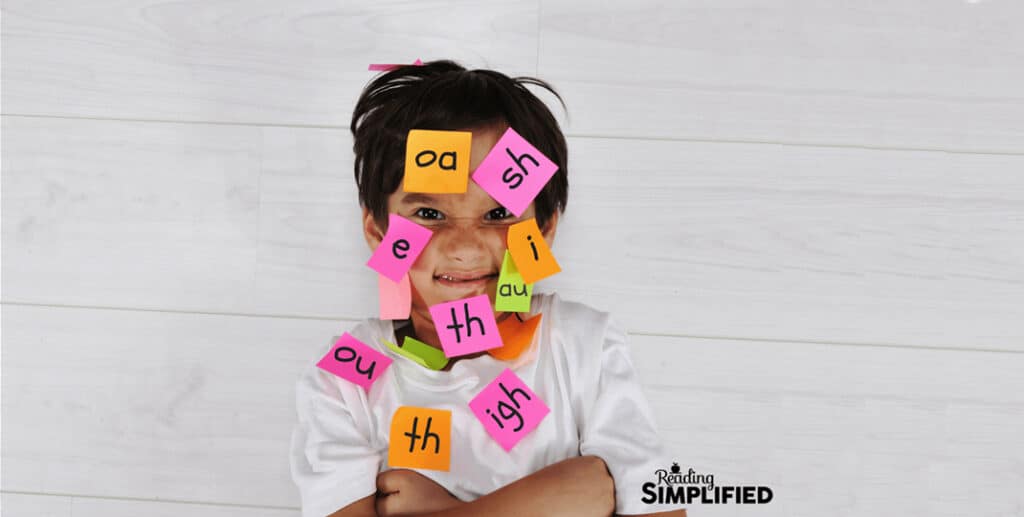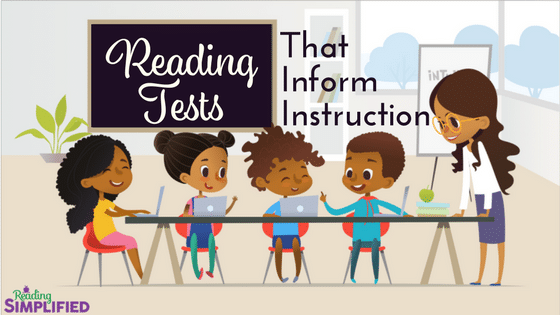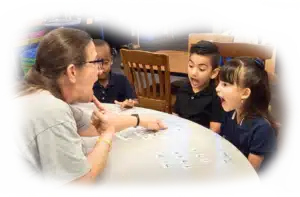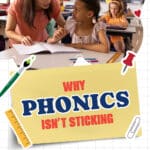
There’s nothing more frustrating than teaching phonics repeatedly to a student, and yet none of it seems to stick!
Even after trying every strategy in your arsenal, the very next day it's as if they've completely forgotten the letter sound you worked so hard to teach them.
Aggggghhhh!
We’ve all encountered students like this, and instead of stressing out about it and trying to figure out what you’re doing wrong, I’m going to tell you exactly why phonics isn't sticking, and more importantly…what you can do about it.
Why Phonics Isn't Sticking–The Foundational Problem
It may seem as if some students have brains like sieves. When phonics or sight word knowledge goes in, it tends to slip right back out again. Nothing seems to stick.
The number one reason why some kids can’t make phonics stick is that they have weak sound-symbol decoding.
If a child has this problem, it means that their brains aren't doing a great job matching sounds with symbols.
Some students will link sounds and symbols haphazardly. They understand the link between some of the letters with sounds, but they don't match up EVERY letter combination with a particular sound.
For instance, a child with weak sound-symbol decoding may come across the word FLAT. She may pronounce FLAT as FAT. As you can see, there is some sound-symbol correspondence there, but it’s not tightly aligned.
When students add or subtract letter-sounds from an unknown word, that's the teacher's cue that they don't have strong sound-symbol decoding.
As a result, the words they are reading are not tightly linking sounds and symbols….
Meaning–their brain can't memorize information that's only loosely linked.
Some kids can trick us with their sound-based decoding. It seems ok–the occasional mistake here and there–but they definitely use sounds to attack unfamiliar words, right?
Most of these types of readers have a hidden reading weakness, though. They have only a partial use of our sound-based code. So, be on the lookout for this weakness.
It's the most common struggle I see in students–by far.
Good readers…or those who will become good readers…notice all the little inside parts of words. They have or are developing strong sound-symbol processing. As a result, words “stick” more easily for them.
Identifying a Sound-Symbol Decoding Weakness
So, how can you tell if a student has a weak sound-symbol decoding problem?
It’s simple.
Listen carefully to the way the child links symbols with sounds. For instance, is she able to identify each sound of the word FLAT?
We want them to see and read /f/ /l/ /a/ /t/.
A student who struggles with sound-symbol processing may leave out the /l/ sound completely, which is a clear sign that there’s an underlying issue.
Another option is to give a quick norm-referenced Nonsense Word Reading assessment. Since the child couldn't have already encountered these nonsense words, the test reveals how strong his/her sound-based decoding system is functioning.
In this post, I share 2 free norm-referenced Nonsense Word Reading tests.
I like to see scores above grade level for Nonsense Word Reading, as good readers are almost always excellent at this.
Making Phonics Stick
Just three core activities can solve a sound-based decoding problem, and they’re easier than you might think:
1. Switch It – where the child reads a word like ‘PIN,’ and the teacher asks her to switch it to ‘PAN’ – simple.
2. Read It – teaching kids to blend the sounds as they read a word.
3. Sort It – where the student deals with advanced phonics information
But there’s one more key – and it’s crucial.
When doing Sort It, it’s not only important to sort the words into the correct sound spellings but to immediately Write and Say each word after it’s sorted.
The Write and Say strategy is a great hack we weave into ALL our word work activities.
THEN – phonics will stick!
Check out the video below for examples of this Write & Say strategy in action with readers from age 4 to 50!
If you'd like to read more about these activities and watch videos of each in action, then click the links above.
OR, I host a complementary on-demand workshop explaining all 3 core activities and how they are so powerful. Head to this link to participate in this workshop, 3 Simple Steps to Science of Reading Success
Sort It as the Main Hub for Making Phonics Stick
Sort It is the main activity in which a lot of other things circle around. Sort It is our primary tool for having students' brains soak up tricky phonics information like the /oa/ in “boat” or “Joe” or “snow.”
This means you'll be able to teach more advanced phonics concepts in weeks vs. months or years.
No more scrambling at the end of the year to get all your phonics standards covered.
Key Sentences Help Phonics Stick
One element of Sort It–the Key Sentence–can be especially useful both for teacher organization and students' rapid up-take of new phonics information.
As we teach a new sound, like the sound /oa/, we also teach a Key Sentence, or mnemonic, to help the students (and the teacher!) quickly recall all the spellings of the target sound.
For instance, the Key Sentence for the /oa/ sound is,
As you can see, there are multiple /oa/ spellings in this sentence. The Key Sentence includes each of the high frequency spellings of a given sound (i.e., o, o_e, ow, oa, & oe) as well as mostly high frequency words (i.e., “go,” “home,” “show,” and “boat.”).
(Inside our paid membership the Reading Simplified Academy, we have a Key Sentence like this for each high-frequency sound. Or, you could create your own….just select high frequency spellings and words for each of the main Advanced Phonics sounds: /oa/, /ee/, /ay/, /i_e/, /er/, /ow/, /oo/, /aw/, /oi/).
Each week we teach 1 new sound, along with its Key Sentence using the Sort It framework.
So, in less than 12 weeks, many students will have learned all the tricky Advanced Phonics sounds and their main spellings, such as the sounds for /oa/, /ee/, /ay/, /er/, /ow/, etc.
Sort It, and the corresponding Key Sentences, are easy, yet fun, ways that students receive a lot of exposure to high-frequency words and spellings.
We lay the groundwork to help sounds and symbols connect for the kids' brains, which is what makes the system so powerful.
With a lot of practice and the right amount of intensity at one sound at a time, everything starts to stick.
The Secret to Transforming Your Reading Instruction
In this video, you'll learn more about this highly effective quick fix, including:
- How to use it effectively,
- What it looks like in a real classroom, and
- The science behind its power.
Watch now to discover how seamlessly you can incorporate the Write and Say strategy into your instruction.







Hi,
I’m looking for this to be useful for my emergent Kindergarten readers…learning letters and sounds. Is Sort It too advanced? Would we just “stick” with Switch It and Read It? Wondering if the Reading Simplified Academy would benefit my little people and I. Thanks!
Great question, Jess!! Yes, Sort It is great fun for Kinders! With Switch It and Read It, they learn the letter-sounds, phonemic awareness, and decoding strategies in a matter of weeks or months. THEN, it’s easy to transition them to Sort it: 1) they can handle the concept that 1 sound can be more than 1 letter and 2) they need to jump into all that Advanced Phonics as fast as possible because the consonants and short vowels make up far less than a fifth all the letter-sounds they’ll need to know to be mature readers.
Lots of kids “camp out” too long in consonants and short vowels so when they move forward, they’re stuck thinking that 1 sound is always 1 letter. We can move at a fast rate so that they don’t get stuck in that rut.
Please let us know if you give Sort It a try!
Can this program be used by a parent for a single child or does there have to be a group dynamic?
Yes! We have a lot of parents teaching their child inside the Reading Simplified Academy. We encourage parents to take special advantage of our online discussion board, aka Teachers’ Lounge, so they can get expert Reading Simplified feedback every day, or frequently, to assure you you’re on the right track and to help you be most efficient.
I used “Sort It” long O kit. An 18 year old stuggled through the words trying to get the /o/ out of his mouth. I reminded him that the multiple spellings all said “O”. About the 20th word it was like a light went on. He sorted all the words and we would read a column when he had two or three words under the heading. Second time through he flew through the words. Happy kid.
Hi Cheryl! Thanks so much for sharing! This is what the program is all about. I’m so glad this is serving your readers well. 🙂
I love Reading Simplified! I’m a tutor and find it very helpful. My question is, when working with a very young learner, do I need to follow a phonics program teaching how to make the sound etc first, before I start Switch It, etc?
Our students learn the letter-sounds right in the context of building or reading words. However, for very young students, we often recommend Build It as a precursor activity to Switch It. You can learn more here: https://readingsimplified.com/?s=build%2Bit
Good day
Thank you for this insightful information. I am a teacher and I sometimes come across learners that add letters in. Example: the one child sounded out water – w-a-t-e-r but then read walter and pronounced the ‘a’ as ‘or’
Why is she adding in a letter that is not there? Is it also due to sound-symbol weakness?
Please help
Thank you
When students add or subtract letter-sounds from an unknown word, that’s the teacher’s cue that they don’t have strong sound-symbol decoding. As a result, the words they are reading are not tightly linking sounds and symbols. The content in this blog is meant to support teachers in building a stronger sound-based decoding foundation in their students https://readingsimplified.com/why-phonics-isnt-sticking/#:~:text=When%20students%20add%20or%20subtract,tightly%20linking%20sounds%20and%20symbols%E2%80%A6.
Thank you so much for the informative reply, Kaylah
Hi! I have been working with a student for almost a year now. When he first came to me, he couldn’t blend sounds together to read words nor did he know his letter sounds very well. He is now able to sound out words and then blend them into words but does not read them automatically. We are now working on digraphs but I am wondering if I made a mistake by moving him to the next skill when he cannot read words automatically yet. Have students mastered a skill if they are able to accurately sound out and blend, but are not able to read it automatically? Should I move back to CVC words until he can read the words with automaticity or keep moving forward with lots of review? I would love to know your thoughts! Thank you so so much!
In general, we would keep moving ahead, unless the child is especially frustrated when we do so. Keep blending sounds as your Most Pressing Need… WHILE you also fold in more and more letter-sounds each week.
Our Switch It activity may help with letter-sound learning and blending, by the way.
Very interested in purchasing your sort it activities. How do I do that?
Thanks for your interest! Most of our materials are on reserve for members of our Reading Simplified Academy and not for individual sale. You can learn more about joining the Academy here: ReadingSimplified.com/academy
I’m interested in participating in the reading simplified academy as a parent as I have 3 dyslexic children (ages 10, 10, 13) who have been in Orton-Gillingham dyslexia intervention programs at school for 3+ years. Oral “Reading” ability seems to have dramatically improved for all 3 due to memorization of words. However all 3 have continue to exhibit extreme difficulties with skill of decoding nonsense words/word attack and encoding/spelling words (as shown by diagnostic testing both before and after program participation).
Many parents and tutors join the Reading Simplified Academy to support their children in your age bracket with similar needs. To learn more about the Reading Simplified Academy please use this link: You can also learn more about joining the Academy here: readingsimplified.com/academy
My 8 year old is struggling, he reads on a 1st grade level and even if he can read a paragraph he can’t tell you what is being said or what the passage is attempting to relay to the reader. Would this be a useful tool?
Yes, we have strategies to help build a strong foundation for sound based decoding, which will make reading easier for him. When reading isn’t automatic, a child’s focus and energy go entirely toward decoding the words, leaving little to no mental space to process and summarize the content. That’s what you’re noticing. For a while, it will be beneficial for him to practice summarizing texts you read aloud to him, as well as daily life events. We can guide children through summarization exercises, not just during reading, but throughout the day—because summarizing is a language skill that can be modeled through conversation. You can learn more about this
https://readingsimplified.com/most-important-question-comprehension-101/
By strengthening his foundational reading and language skills in this way, you’ll be laying supportive groundwork. In the Reading Simplified Academy, our assessments and coaching in The Teachers Lounge can offer more tailored guidance to help you create a plan specific to your son’s needs.
Excellent explanation of why phonics isn’t sticking! The practical strategies like ‘Switch It’ and ‘Sort It’ are game-changers.
Thank you Sudha!! We agree. 😉